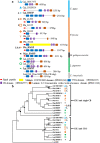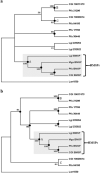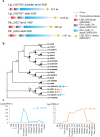Phylogenetic comparisons reveal mosaic histories of larval and adult shell matrix protein deployment in pteriomorph bivalves
- PMID: 33335265
- PMCID: PMC7747718
- DOI: 10.1038/s41598-020-79330-x
Phylogenetic comparisons reveal mosaic histories of larval and adult shell matrix protein deployment in pteriomorph bivalves
Abstract
Molluscan shells are organo-mineral composites, in which the dominant calcium carbonate is intimately associated with an organic matrix comprised mainly of proteins and polysaccharides. However, whether the various shell matrix proteins (SMPs) date to the origin of hard skeletons in the Cambrian, or whether they represent later deployment through adaptive evolution, is still debated. In order to address this issue and to better understand the origins and evolution of biomineralization, phylogenetic analyses have been performed on the three SMP families, Von Willebrand factor type A (VWA) and chitin-binding domain-containing protein (VWA-CB dcp), chitobiase, and carbonic anhydrase (CA), which exist in both larval and adult shell proteomes in the bivalves, Crassostrea gigas and Pinctada fucata. In VWA-CB dcp and chitobiase, paralogs for larval and adult SMPs evolved before the divergence of these species. CA-SMPs have been taken as evidence for ancient origins of SMPs by their presumed indispensable function in biomineralization and ubiquitous distribution in molluscs. However, our results indicate gene duplications that gave rise to separate deployments as larval and adult CA-SMPs occurred independently in each lineage after their divergence, which is considerably more recent than hitherto assumed, supporting the "recent heritage and fast evolution" scenario for SMP evolution.
Conflict of interest statement
The authors declare no competing interests.
Figures





Similar articles
-
Dual Gene Repertoires for Larval and Adult Shells Reveal Molecules Essential for Molluscan Shell Formation.Mol Biol Evol. 2018 Nov 1;35(11):2751-2761. doi: 10.1093/molbev/msy172. Mol Biol Evol. 2018. PMID: 30169718 Free PMC article.
-
Evolution of nacre- and prisms-related shell matrix proteins in the pen shell, Atrina pectinata.Comp Biochem Physiol Part D Genomics Proteomics. 2022 Dec;44:101025. doi: 10.1016/j.cbd.2022.101025. Epub 2022 Aug 31. Comp Biochem Physiol Part D Genomics Proteomics. 2022. PMID: 36075178
-
Diversification of von Willebrand Factor A and Chitin-Binding Domains in Pif/BMSPs Among Mollusks.J Mol Evol. 2024 Aug;92(4):415-431. doi: 10.1007/s00239-024-10180-1. Epub 2024 Jun 12. J Mol Evol. 2024. PMID: 38864871 Free PMC article.
-
Review: Post-translational modifications of marine shell matrix proteins.Comp Biochem Physiol B Biochem Mol Biol. 2021 Oct-Dec;256:110641. doi: 10.1016/j.cbpb.2021.110641. Epub 2021 Jun 25. Comp Biochem Physiol B Biochem Mol Biol. 2021. PMID: 34182126 Review.
-
The evolution of mollusc shells.Wiley Interdiscip Rev Dev Biol. 2018 May;7(3):e313. doi: 10.1002/wdev.313. Epub 2018 Feb 22. Wiley Interdiscip Rev Dev Biol. 2018. PMID: 29470863 Review.
Cited by
-
Comparative Single-Cell Transcriptomics Reveals Novel Genes Involved in Bivalve Embryonic Shell Formation and Questions Ontogenetic Homology of Molluscan Shell Types.Front Cell Dev Biol. 2022 Jun 9;10:883755. doi: 10.3389/fcell.2022.883755. eCollection 2022. Front Cell Dev Biol. 2022. PMID: 35813198 Free PMC article.
-
Creatinine index as a predictive marker of sarcopenia in patients under hemodialysis.Int Urol Nephrol. 2022 Jul;54(7):1565-1573. doi: 10.1007/s11255-021-03032-0. Epub 2021 Oct 21. Int Urol Nephrol. 2022. PMID: 34674147
References
-
- Morris SC. The Crucible of Creation: The Burgess Shale and the Rise of Animals. Highlands Ranch: Peterson's; 1998.
-
- Shubin NH, Marshall CR. Fossils, genes, and the origin of novelty. Paleobiology. 2000;26:324–340. doi: 10.1017/S0094837300026993. - DOI
-
- Lowenstam HA, Weiner S. On Biomineralization. Oxford: Oxford University Press on Demand; 1989.
-
- Carter JG, Clark GR. Classification and phylogenetic significance of molluscan shell microstructure. Stud. Geol. Notes Short Course. 1985;13:50–71. doi: 10.1017/S0271164800001093. - DOI
Publication types
MeSH terms
Substances
LinkOut - more resources
Full Text Sources
Miscellaneous

